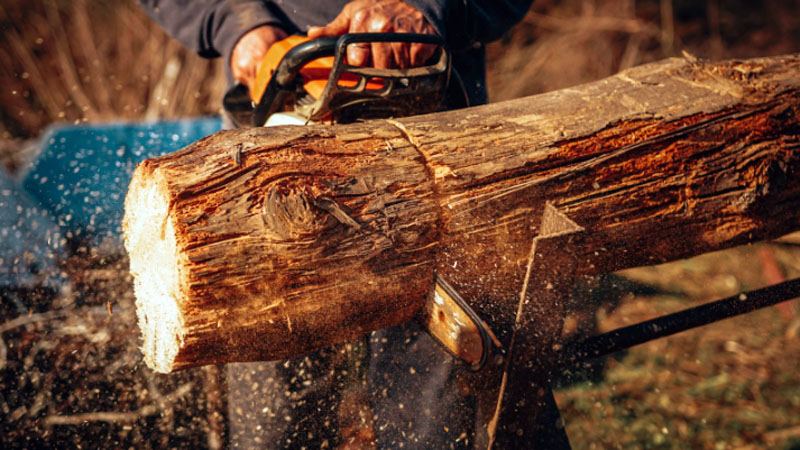Mastering the Art of Using a Chainsaw in Adverse Weather: Expert Tips and Tricks
Chainsaws are essential tools for tree trimming, pruning, and cutting wood. With the right chainsaw blades, chainsaw chains, and a chainsaw blade sharpener, tasks like pruning, bucking, and felling trees can become simple and efficient. However, it's important to remember that this powerful tool can also pose serious risks if not used properly. Chainsaw safety should always be a top priority before using your equipment. This includes understanding how to maintain and use your chainsaw chain, blade, and other parts, as well as wearing appropriate chainsaw safety gear. Additionally, being aware of weather conditions is crucial when operating a chainsaw. Let’s explore how to use a chainsaw safely in different weather conditions. Let’s dive in! Proper chainsaw safety techniques are especially important in cold weather, where snow and ice can create additional hazards. Here are some key tips to keep in mind when using your chainsaw in freezing temperatures. When working with a chainsaw in cold weather, wear a warm, flexible jacket that allows for easy movement. Eye protection, such as safety goggles, and gloves are essential. Avoid loose clothing like scarves, which could get caught in the chainsaw. Choose durable, non-slip shoes to ensure stability on icy surfaces. Frozen wood can be more difficult to cut, so make sure your chainsaw chain is freshly sharpened. A well-maintained blade will perform better and reduce the risk of kickback. It’s also wise to have at least two spare chains on hand in case of emergencies. If you're working in temperatures below freezing, consider using a carbide-tipped chain. These chains are designed to handle frozen wood more effectively and reduce wear on the blade. Before starting your chainsaw in cold weather, inspect it for any dirt or debris that may have accumulated around the chain sprocket. Clean the chain groove if necessary. Also, check the spark plug and air filter—replacing them if needed can help ensure smooth operation in low temperatures. Cold weather can make it harder to start a gas-powered chainsaw, as fuel and oil thicken. To improve starting performance, pull the starter cord slowly and steadily. This helps the engine ignite more easily and reduces the risk of stalling. The main danger when using a chainsaw in hot weather is overheating. If the engine becomes too hot, it can seize up, causing the chain to break and potentially leading to injury. Here’s how to stay safe during summer operations. Even in hot weather, always wear gloves to prevent slipping due to sweat. Long sleeves and a helmet protect against flying debris, while safety goggles shield your eyes from splinters and dust. Staying protected is essential for maintaining control over your chainsaw. To prevent overheating, clean your chainsaw with a wet rag before use. A dirty chainsaw is more likely to overheat. Lubricate the chain to reduce friction and heat buildup. Most modern chainsaws come with an automatic lubricator, so simply add bar oil to keep things running smoothly. If your chainsaw has accumulated heat, it may be difficult to start. Replacing the spark plug and air filter can help restore normal operation. Stick to the types of jobs your chainsaw was designed for to avoid overloading the engine and risking a breakdown. Gas-powered chainsaws can be used in rainy conditions without issues, but electric or battery-powered models should be avoided to prevent electrocution. Water can cause short circuits, so it's best to use only gas chainsaws in wet weather. Slick surfaces can increase the risk of slips and falls, so take extra precautions when working in the rain. Wear gloves with a firm grip and non-slip boots to maintain control on wet surfaces. A chainsaw visor and helmet offer additional protection, while avoiding safety glasses ensures clear vision. Before starting your chainsaw in wet weather, check the chain tension and condition. Ensure that the oil and fuel levels are correct to prevent engine damage. Clean or replace your air filter before starting your saw in wet conditions. Moisture can cause dust to expand and clog the filter, leading to poor performance. Using a chain with rounded or semi-chisel teeth is ideal for cutting wet wood. Practising chainsaw safety begins with proper maintenance of your chainsaw parts, including your chainsaw blade and chain. Wearing the right safety gear, such as eye protection, gloves, and a helmet, is also essential. At Jono & Johno, we offer a wide range of chainsaw blades, chainsaw chains, and other spare parts. We also provide various chainsaw blade sharpener options to keep your equipment in top condition. Get in touch with us to learn more about our chainsaw spare part options and place your order today! Windows And Doors Profiles,Aluminium Profiles For Windows And Doors,Wood grain,Doors And Windows Profiles,window and door Sinogar Metal Co.,Ltd , https://www.sedinoaluminium.comCold Weather: Using Chainsaw Blades and Chainsaw Chains Safely

Proper Clothing and Gear for Cold Weather Chainsaw Use
Pre-Starting Checks for Cold Weather Chainsaw Use
Tips for Starting and Operating a Chainsaw in Cold Weather
Hot Weather: Using a Chainsaw Blade and Chainsaw Chain Safely
Proper Clothing and Gear for Hot Weather Chainsaw Use
Pre-Starting Checks for Hot Weather Chainsaw Use
Tips for Starting and Operating a Chainsaw in Hot Weather
Wet Weather: Practising Chainsaw Safety with the Right Chainsaw Safety Gear
Proper Clothing and Gear for Wet Weather Chainsaw Use
Pre-starting Checks for Wet Weather Chainsaw Use
Tips for Starting and Operating a Chainsaw in Wet Weather
Chainsaw Parts: Explore Our Chainsaw Spare Parts, Like Our Chainsaw Blade Sharpener
